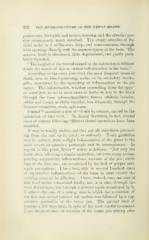Page 310 - My FlipBook
P. 310
282 THE MICRO-ORGANISMS OF THE HUMAN MOUTH.
periosteum, bicuspids and molars wanting, and the alveolar pro-
cess consequently much resorbed. The empty alveolus of the
third molar is 6 millimeters deep, and communicates through
wide openings directly with the marrow-spaces of the bone. The
marrow itselt is discolored, fatty degenerated, and partly puru-
lently liquefied.
" The neglect of the wound caused by the extraction is without
doubt the source of this so violent inflammation in the bone."
According to the cases just cited, the most frequent cause of
death, next to blood-poisoning, seems to be secondary menin-
gitis, occasioned by the spreading of inflanmiation to the pia
mater. The inflammation, whether proceeding from the upper
or lower jaw, seems in most cases to make its way to the brain
through the fossa spheno-maxillaris, flssura orbitalis inferior,
orbita and flssura orbitalis superior, less frequently through the
foramen rotundum, ovale, spinosum.
Conrad ^"^ mentions a case of " death by tetanus, caused by the
extraction of two teeth." In dental literature, in fact, several
cases of tetanus following difl:erent dental operations have been
recorded.
It may be readily understood that not all infections proceed-
ing from the oral cavity result so seriously. Every gradation
may be noticed, from a slight inflammation of the gums to the
most severe suppurative periostitis and its consequences. In
regard to this point, Ritter^*^" writes as follows: "ISTot only the
foetor often following a simple extraction, but even many accom-
panying suppurative inflammations, necrosis of the jaw, swell-
ings of the face, etc., are occasioned by the lack of proper anti-
septic precautions. I have been able in several hundred cases
of suppurative inflammations of the bone to trace clearly the
exciting cause of the afl'ection. I have, indeed, seen one case of
this kind which terminated fatally, not, it is true, through the
local disturbance, but through a general sepsis occasioned by it.
I refer to the case of a young man in which the extraction of
the first and second inferior left molars was followed by a sup-
purative periostitis of the lower jaw. The patient died of
pyaemia a few days later, in spite of the most careful treatment.
I saw frequent cases of necrosis of the lower jaw arising after


